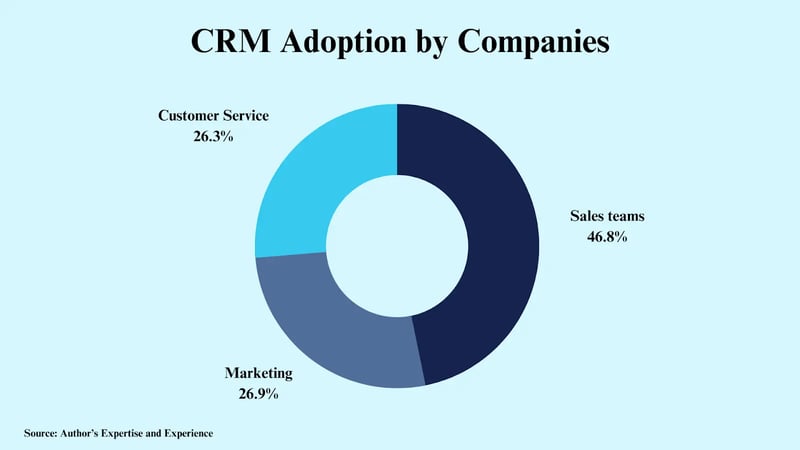让销售和营销协同工作对公司发展至关重要。它能为客户提供统一的体验。然而,销售和营销团队往往不能很好地协调。这是许多企业面临的共同问题。


一项研究显示,32% 的公司最近开始使用 CRM(客户关系管理)软件。这表明,越来越多的公司开始使用 CRM 来连接销售和营销。
在本文中,我们将探讨 CRM 工具如何将销售和营销联系在一起。我们还将讨论
- 连接销售和营销的影响
- 客户关系管理工具如何连接销售和营销
- 克服挑战的方法
- 新趋势
- 常见问题
我们的目标是展示客户关系管理如何成为销售和营销团队之间的桥梁。只要使用得当,它就能创造强有力的协作。
销售与市场营销协调一致的必要性
销售和营销团队的合作至关重要。当他们合作时,会对几个关键领域产生影响:
当销售和营销保持一致时,公司的收入和利润都会受益。简单的 CRM 应用程序可以通过连接团队来推动业务增长。通过客户关系管理软件实现的顺畅交接,可以改善潜在客户的生成和管理。以客户为中心的战略结合了销售和营销部门的洞察力。
通过移动客户关系管理应用程序促进协调,公司在收入、潜在客户和客户满意度等关键指标上都能取得更显著的成果。
当团队之间没有矛盾时,统一的品牌形象就会出现。但是,销售和营销往往不协调。
这种错位会导致若干问题。当潜在客户从两个团队的夹缝中脱颖而出时,潜在客户培育工作就会出现问题。由于细分市场和信息不匹配,导致目标定位无效。重复劳动和成本造成资源浪费。如果不能共享客户洞察力,就会出现数据和沟通孤岛。
协调销售和营销对于公司的成功极为重要。因此,使用 CRM 软件可以帮助连接这两个团队。
客户关系管理集成工具如何帮助连接销售与营销
客户关系管理(CRM)软件通过整合销售和营销数据来帮助公司。这样就能更好地开展团队合作。从下图中我们可以看到,CRM 的应用在各公司中持续增长:

以下是 CRM 改善销售和营销的五种方法:
A.共享客户视图
CRM 工具将所有客户数据集中在一个地方。这种统一的视图在很多方面都有帮助:
-
营销团队可以看到过去与客户的所有销售对话。这样,营销团队就能发送更有针对性的广告。这些广告应根据销售团队所了解的情况与客户相关。利用人工智能进行客户细分可以简化这一过程。
-
销售团队成员可以看到客户从营销部门收到的所有广告和电子邮件。这有助于销售团队个性化推销和报价。他们可以谈论客户感兴趣的产品。
-
客户支持团队可以访问整个对话历史。这有助于他们更快地解决问题。他们不必再要求客户解释一切。
-
公司的管理人员可以看到完整的客户数据。这有助于他们做出更好的产品选择、定价、招聘等决策。
客户关系管理通过共享数据打破了团队之间的隔阂。每个人都与客户站在同一条起跑线上。研究表明,91% 的中型企业现在都在使用 CRM。它可以帮助企业在各个团队之间创建共享的客户视图。
B.简化销售流程
客户关系管理工具通过将重复性的销售任务自动化,使这些任务变得快速而简单:
-
通过在线表单实现数据录入自动化。无需重复手动输入相同的信息。
-
通过工作流自动组织销售线索--不再需要杂乱无章的电子表格来管理销售线索。
-
自动设置电子邮件序列,以便与潜在客户联系。这样就能以更少的手动工作获得更多的接触机会。
-
仪表板自动生成报告。关键指标实时可见,无需手动报告。
有了 CRM,销售团队成员可以更快地开展工作,而无需进行繁琐的文书工作。这为他们节省了时间。他们可以把更多精力放在建立关系等重要工作上。许多团队都认为,在手机和平板电脑上使用 CRM 应用程序后,他们能完成更多工作。CRM 提高了销售团队的工作效率。
C.更好的团队协作
CRM 将销售和营销数据联系在一起,打破了各自为政的局面:
-
销售和营销人员可以立即访问相同的集中数据。无需等待别人发送报告或电子邮件。
-
营销计划可以与销售目标相匹配。当团队在 CRM 中协作时,他们还需要更精确的想法。
-
销售和营销人员可以在 CRM 平台上共同开展营销活动。这能提高一致性。
-
高管和经理可以在一个地方了解销售和营销指标。这样就能全面了解情况。
研究表明,65% 的移动 CRM用户实现了销售目标,而没有使用 CRM 的团队只有 22%。作为一个综合团队,密切合作会带来巨大的成果。
D.高级分析
客户关系管理分析通过对客户数据的分析提供深刻的见解:
E.改善客户服务
客户关系管理通过为代理商提供完整的信息来改善客户服务:
-
代理商可以在一个地方获得完整的客户历史记录,从而更好地了解情况。
-
由于所有数据都已在 CRM 系统中,无需等待其他团队,因此响应速度更快。
-
利用工作流工具,可以将问题更顺畅地转给正确的团队。
-
知识库可为座席人员快速解答常见问题。
-
完整的客户数据可提高服务互动的满意度。
总之,CRM 软件通过共享数据将销售和营销团队联系起来。这就形成了紧密的协调,而孤立的团队和信息是不可能做到这一点的。CRM 整合对于提高现代企业的销售和营销效率至关重要。
客户关系管理集成的变革性影响
让我们来探讨 CRM 集成在销售和营销流程中推动的数据支持变革。
A.改进销售线索管理
客户关系管理有助于在营销和销售之间更好地管理销售线索。有了客户关系管理,销售线索的转移会更加顺畅。市场营销人员可以在 CRM 平台上轻松地将销售线索移交给销售团队。潜在客户培育也得到了改善。市场营销和销售部门可以共同制定战略,对潜在客户进行鉴定和培育。客户关系管理数据有助于确定哪些销售线索需要优先关注。
一项民意调查显示,47% 的企业将增加客户服务CRM 的支出。这是为了通过团队间更好的协作来促进潜在客户管理。
B.数据驱动决策
客户关系管理软件将销售、营销和服务团队的客户数据结合在一起。它将这些数据与营销分析功能整合在一起。这样就能以数据为导向,了解
-
哪些营销活动效果好,哪些效果不好?
-
销售漏斗中销售线索的转化率。
-
销售周期的模式和季节性。
有了这些客户关系管理分析功能,就能做出以数据为导向的决策:
市场证实了数据驱动型 CRM 的价值。预计到 2025 年,CRM 软件的全球收入将超过 800 亿美元。公司正在利用集成的 CRM 数据和分析技术做出更明智的决策。
克服 CRM 整合中的挑战
在销售和营销中整合 CRM 有很大的好处。但它也伴随着挑战。以下是一些克服常见障碍的方法:
-
首先获得高管的支持。自上而下的支持对于采用 CRM 至关重要。向领导层展示 CRM 如何通过协作推动增长。用透明的解决方案来消除顾虑。
-
让团队参与推广。销售和营销部门应就工作流程提出意见。这将提高对新工具的接受度和舒适度。
-
在迁移到 CRM 之前清理客户数据。垃圾进,垃圾出。如果数据杂乱无章,CRM 分析就会受到影响。
-
按团队或地区分阶段推出。循序渐进地导入 CRM 会减少干扰。这样可以在全公司采用之前进行测试和学习。
-
全面培训 CRM 功能。由于缺乏学习,许多人未能充分利用 CRM。持续的教育可以减少摩擦。
-
将激励措施与 CRM 目标相结合。对支持平台中跨团队协作的行为进行补偿。
-
通过适当的变革管理,企业可以克服障碍。CRM 整合可能会遇到障碍,但会带来巨大价值。
未来趋势与演变
随着 CRM 集成的发展,新的趋势正在出现:
-
AI CRM: 客户关系管理平台现在使用人工智能来进行智能预测和提出建议。例如,Salesforce Einstein 或HubSpot AI。
-
混合云/多云: 企业正在混合使用公共云、私有云和现场模式来进行客户关系管理。
-
行业 CRM: 现在有专门针对特定行业的 CRM 平台。
这些趋势表明,CRM 整合正变得更加智能和定制化。
不断上升的 SaaS CRM 市场证实了这一方向。到 2026 年,SaaS CRM 支出预计将达到 420 亿美元。它将占据 CRM 软件总支出的 75%。
企业希望CRM系统是为其行业设计的,并具有智能人工智能功能。他们还希望 CRM 能与他们使用云计算服务的计划相匹配。为了满足这些需求,CRM 集成正变得越来越先进。
结论
总之,整合 CRM 可以在销售和营销团队之间建立紧密的协作关系。它可以统一客户数据,实现单一视图。它可以简化工作流程,将团队联系起来。它还提供了共同的目标和衡量标准。有了 CRM,销售和营销就能无缝协作。
这将通过增加收入、提高销售线索和改善客户体验来推动业务增长。对于寻求增长的公司来说,利用 CRM 调整销售和营销应该是一个优先事项
客户关系管理常见问题











.webp?width=352&name=Call%20centres%20still%20relevant%20(1).webp)
发表评论